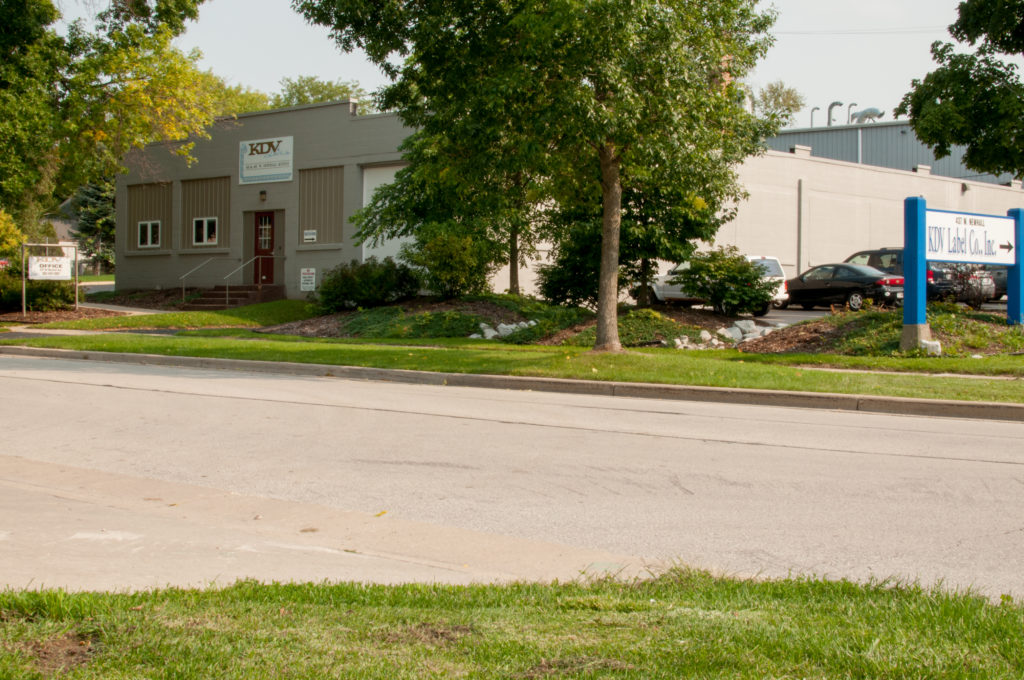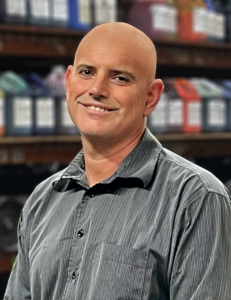
“We pride ourselves on learning from recommendations and ideas of vendors like Channeled Resources Group – in this case, it puts us at the forefront of environmental efforts.”
Shane Vaughn, CEO and President, KDV Label
Overview
A history of growth through quality, consistency, and performance
Founded in 1974 in the garage of Karen and Dick Vaughn near Waukesha, Wisconsin, KDV found an early niche in the dairy industry. They soon began shipping products as far south as Arkansas and out to customers along the East coast. Today, KDV ships to more than 40 states and several countries.
Quality, consistency, and performance were building blocks of the reputation that has grown KDV from a humble start to an expanding location with 3 presses and 12 employees in 1981 (most of whom are still with the company) to 19 presses, 135+ employees, and two locations today. 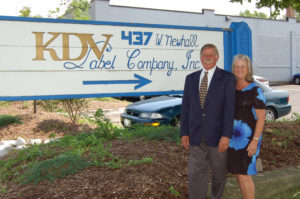 KDV remains a family operated business with the second generation, Shane Vaughn as KDV president and CEO; and the third generation taking a leadership role with Taylor Vaughn as Director of Human Resources.
KDV remains a family operated business with the second generation, Shane Vaughn as KDV president and CEO; and the third generation taking a leadership role with Taylor Vaughn as Director of Human Resources.
KDV carries on a strong tradition of representing the brands and products of its customers with quality, custom, print and label solutions. As technology, materials, and applications have changed over the years, KDV has adapted and grown capabilities to meet their customers’ needs. According to Vaughn, “our brand is built on communication, follow-up, and follow through. We are proud of the work we do to add value to each of our customer’s brands by producing quality labels.”
For more of KDV’s history, visit www.kdvlabel.com/about-us-2/history/.
The Challenge
KDV’s Ongoing Commitment to Environmental Responsibility
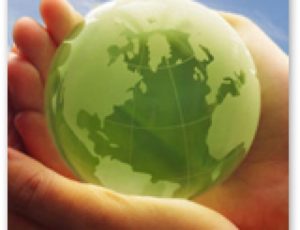 KDV approaches sustainability by focusing its efforts into three primary categories: business operations, customer solutions, and employees and community advocacy and education. Vaughn notes, “KDV takes pride in our commitment not only to our customers but also to our community and environment. We have made significant investments for almost 20 years to continuously reduce our environmental impact. And now, with the addition of Katie Austing, Marketing and Sustainability Manager, we continue to build on that history.”
KDV approaches sustainability by focusing its efforts into three primary categories: business operations, customer solutions, and employees and community advocacy and education. Vaughn notes, “KDV takes pride in our commitment not only to our customers but also to our community and environment. We have made significant investments for almost 20 years to continuously reduce our environmental impact. And now, with the addition of Katie Austing, Marketing and Sustainability Manager, we continue to build on that history.”
Starting in the early 90’s KDV began to transition away from solvent-based inks. This movement, coupled with investments in printing presses that have superior drying technology, provides the same quality product to the consumer with increased positive environmental consequences. This change also makes for a safer and more pleasant working environment for KDV employees.
In 2000, KDV’s plate department upgraded to digital manufacturing of plates. This eliminated photographic negative chemistry due to laser engraving of printing plates. In 2002, KDV made a significant investment in a solvent-free plate making system. By doing this they eliminated a significant amount of chemicals that had previously contained exposed photopolymer.
In 2007, KDV eliminated alcohol in cleaning solutions, opting for an organic cleaner that can now perform as well as the alcohol-based product. This has resulted in a reduction of 16,000 pounds of volatile organic compounds (VOCs) being released into the atmosphere. The large reduction in VOCs 17+ years ago is based on implementing solventless plate making, eliminating ethyl acetate, and reducing solvent inks. From 2006 through 2011, KDV continued to consistently reduce their VOCs even as their production grew, and have since stayed proportionately steady.
The latest facility expansion in 2008 gave the company the opportunity to switch to energy efficient lighting which provides excellent lighting using less energy. In 2019, KDV continued efforts to reduce their carbon footprint by replacing all the lighting in the manufacturing area with high efficiency LED lighting.
In 2009, KDV consumed 1,374,000 gallons of clean water plant-wide, with the majority of that water used for cleaning. After installing new cleaning technology, KDV was able to reduce clean water usage to 985,000 gallons. This represents a significant savings of 389,000 gallons, a 28 percent reduction. KDV has maintained these reductions even as they have grown and production has increased.
KDV also improved their impact on the environment in 2010 with two new initiatives. Through a solvent recovery program, 543 gallons of solvent are no longer entering the environment on an annual basis. KDV also began using the zero-landfill, oil absorbents eliminating 38,501 pounds of towel waste each year.
Focused Impact
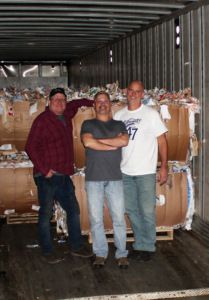 One of the most significant, ongoing sustainability efforts at KDV is keeping non-recyclable waste out of landfills. KDV has been growing this program since the early 1990s when they began sending matrix waste to be converted to fuel pellets. And when Channeled Resources introduced them, Convergen Energy became part of this long-standing program.
One of the most significant, ongoing sustainability efforts at KDV is keeping non-recyclable waste out of landfills. KDV has been growing this program since the early 1990s when they began sending matrix waste to be converted to fuel pellets. And when Channeled Resources introduced them, Convergen Energy became part of this long-standing program.
Convergen Energy, a Green Bay, Wisconsin alternative fuel producer, converts non-recyclable, industrial by-products into an alternative fuel that can be used to replace fossil fuel sources and produce renewable energy. Since 2009, Convergen has diverted over 600,000 tons (1.2 billion pounds) from landfills into energy alternatives. This is enough waste material to more than fill three entire Empire State Buildings. The Convergen Energy solution provides a very low carbon footprint and reduces greenhouse gas emissions significantly compared to any other method of power generation that uses fossil fuels such as coal or natural gas.
Austing notes that, “Logistics/proximity to a recycler is a prime obstacle for many label manufacturers in being able to recycle material waste and we are lucky to have a recycler locally. Our Waukesha, Wisconsin location sends 10-13 tons of baled materials to Convergen every 4-6 working days.”
The Outcome
This solution provided KDV with three top benefits: landfill avoidance, energy creation and waste compacting. They routinely conduct training and monitoring of what is allowed in the compactors/fuel pellets and maintain an open dock to store the bails of matrix and regularly call for pickup.
KDV discovered that in addition to renewable energy being good for the environment, they would save money in the long-run by recycling matrix versus landfilling the material. “Currently, we are sending more than 1.3 million pounds of waste to Convergen each year. And of course, we continue to look for ways to divert or recycle more of our byproduct.” Austing notes, “Additionally, we are working with our end users, as Channeled Resources has led by example in doing. It has been a great way to grow sustainability efforts while further supporting our customers.”
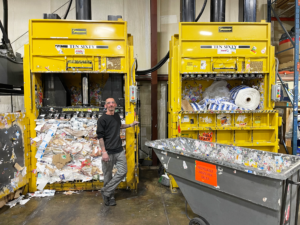
This renewable energy solution demonstrated to their customers that they could count on KDV to help support their own sustainability goals, as well as some security needs. For those customers who request proof of destruction, documentation of recycling typically meets these requirements.
Vaughn adds in conclusion, “We look forward to advancing and amplifying these efforts to support the sustainability goals of KDV, our customers, and our community. “
